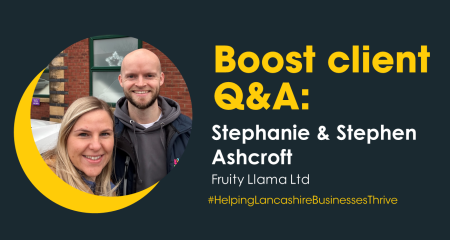
Here, Andrew Ramwell, a Boost business adviser on the Growth Catalyst and Scale to Thrive programmes, outlines five key pointers to help small business owners who may be overwhelmed by the information and advice on hand, to get started with smart marketing.
What we’ve learnt working with thousands of small businesses (and many bigger businesses), is that most people haven’t really sat down and thought what marketing means to them and what they need it to do for their business right now.
Markets are dynamic and customers’ needs and wants are ever changing and your marketing strategy must keep up. This isn’t about what you’ve done before, but what you need to do now to achieve a specified business outcome.
To do this, you must be clear on what you need your business to achieve. Clear goals and objectives will help to focus in on the right marketing solution to support your business. Think about your current state and the desired future you want for your business.
For example, if you want to earn a £50,000 income from the business, you’ll likely have to be turning over a lot more than that to cover costs. This means that you need to figure out what you’re selling, who you believe will buy it, and how much you’ll need to sell to make the income required.
This will then help you to focus on understanding where your potential customers are.
You might also include other non-financial goals that are important to you to build into your business such as expressing organisational values, developing ethical supply chains, work/life balance, investing in staff, and profit shares as some ideas.
These will also influence the type of customer that is attracted to work with you.
Not all customers are equal, and you need to think carefully about who you want to deal with. What or who would be an ideal customer for you and why? Think about some of the attributes they would need to be your customer.
Aside from an obvious need or want for your products or services there are other considerations such as you might have a price point that excludes some customers, you might have a geographical restriction on your services, or a minimum or maximum order volume. Identifying a list of factors will begin to help you to hone in on an ideal target customer profile.
The flipside of this would be thinking about what would make a bad or less than ideal customer for you. This can include the likes of out and out scammers, consistent late payers, someone who is overly demanding and expects more than they paid for, and those who don’t really value your services. Different things make for bad clients for each business proposition. You’ll need to think through who or what you’d prefer not to have on your books.
Neither list is exhaustive. However, if you can list out who you do and don’t want, you can begin the process of filtering clients in or out through each stage of your marketing process. Remembering that your marketing should attract and repel in equal measure.
Your potential customers don’t really care about what you’re selling, they’re only interested in what it does for them. Take the time to develop a clear value proposition; the promise of the value you’ll deliver to your customers when using your product, service, or solution.
The clearer this value is, the more likely people are to respond and engage with you. For example: Helping small businesses grow their online presence by an average of 30 per cent in the first three months.
Don’t make the mistake of the old-fashioned marketing approach of ‘spray and pray.’ This is where people spread the message as far and wide as they think they can and hope enough people respond. People will simply ignore this nowadays and are more likely to block you, which impacts your digital footprint via the many algorithms provider’s use. The more you can target your message to your ideal customer, the less time and resource you also spend trying to engage the wrong people.
Take the time to understand the current marketplace and how your customer base engages with it. It’s easier to research your defined marketplace when you have a clear goal in mind.
Think about the many different forms of marketing both online and offline and where your ideal customers attention is currently focused. Which of these have you tried and why?
Most people are on seven different social media apps but will use two or three primary ones. Which ones should you focus in on? With a limited budget you cannot expect to excel on all platforms. Without understanding the algorithms that drive content you could be wasting your marketing money. Something is not better than nothing in this case.
You need to quickly figure out what to measure, why something is important, and how to leverage it for better results. Marketing needs a plan with a defined goal and series of steps to be tracked and followed. It never ceases to amaze me how many people blindly push out content with no coherent approach that they measure and use the results to learn and improve their performance.
There are all manner of metrics you can choose and the more you know exactly what you want to achieve, the type of ideal customer you’re aiming at, then the easier it is to begin to put together a list of key performance measures that support you in your endeavour.
Above all keep it simple. A good comparison would be to consider the NHS Couch to 5K app that exploded during the pandemic. It helped millions of people to literally get off the couch and build up towards running (and even enjoying) a 5km run. It gave them a clear list of things to work through at the beginning to help them assess their current state and prepare them for the work ahead. Armed with a clear plan and stated objective, they could chip away and register their progress and get support as they went along to achieve their end goal.
Think about how to build a marketing plan that moves you from where you are now, to somewhere you’d like to be, and then work through the steps above to flesh out the details. Once you are clear about the end point, it’s easier for people to support you with ideas and suggestions of how you could achieve this. Finally, remember your circumstances might change, if so, reset and go again.
About the contributor
 Andrew Ramwell has experience working within varying business areas across the private, public and charity sectors. As a Boost business adviser, he likes helping growing and scaling businesses to deliver results via increased sales, managing change and growing teams.
Andrew Ramwell has experience working within varying business areas across the private, public and charity sectors. As a Boost business adviser, he likes helping growing and scaling businesses to deliver results via increased sales, managing change and growing teams.
Boost is helping Lancashire businesses thrive.
We have a range of funded support programmes and a team of business advisers you can talk to.
To speak to someone from the Growth Hub about business support, contact Boost online or call 0800 488 0057.




The website uses cookies.
Some are used for statistical purposes and others are set up by third party services. By clicking 'Accept all & close', you accept the use of cookies. For more information on how we use and manage cookies, please read our Cookie Policy.